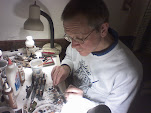In the summer of 174x, the Nth year of the War of the Western League, an army of the Pragmatic Coalition was advancing northward in an effort to lay siege to the city of Schluesselbrett, and perhaps cause the Archbishop to sue for peace separately. However, the Archbishop had turned his defenses over to General Schachlaufer (reportedly a
nom-de-guerre of the notorious mercenary general MacDuff). Schachlaufer, whose
coupe de lo’oeil seldom failed him, looked over the possible approach routes to the city, and chose to make a stand at Gelbehuegel, where the northward roads converged, and the then combined route ran through a defile which would allow him to make the most of his limited troop strength.
 |
| The battlefield, before the arrival of the armies. Schachlaufer’s line of deployment in red, roads used by converging Coalition columns in green, North to the top of the picture. |
He had available to him two brigades of troops, a native Schluesselbrett contingent of two infantry battalions, a battery of artillery, and a squadron of light dragoons, and an allied brigade of two infantry battalions and an artillery battery from Hesse-Hattemstadt (in blue coats) and a battalion of Saxe-Kirchdorf jaegers (in purple).
 |
| Later in the battle, but illustrating the deployment of the League forces, with Schuesselbrett troops on the southern hill, allies on the northern, and the light dragoons in reserve on the road |
As seen in the illustration, he elected to deploy with his local brigade guarding the hill to the south (his right) and the allied brigade guarding the hill to the north (his left). With the troops emplaced, there was nothing to do but await the approach of the enemy.
The plans of the Pragmatic Coalition that day were flawed from the outset. Bad maps had led General Nordstrom (a distinguished Wachovian officer in overall command of the Coalition forces) to believe that two roads continued to parallel each other beyond the defile at Gelbehuegel, and that the actuals hills north of the town were less of an obstacle than was actually the case. He had divided his forces into an infantry column (of five battalions of line infantry, a battalion of jaegers, and a battery of artillery) and a cavalry column (four squadrons of various cavalry supported by a battalion of veteran Wachovian line infantry and a second battery of guns).
 |
| Coalition infantry deploying and attempting to assault the northern hill |
There was a great deal of confusion as the heads of the columns ran into each other in the streets of Gelbehuegul. General Nordstrom found himself stuck in the back of the infantry (left) column attempting to bring some order to the chaotic situation. At the front of the infantry column, his subordinate, General Adelmann, was the first to see that that the enemy had decided to make a stand at the defile. He ordered the lead battalions of infantry to deploy and to attack the lower slopes of the northern hill, where the enemy artillery could be seen deployed, and the King Rupert Jaegers to attack the southern hill, using light infantry tactics to (hopefully) suppress the battery there, and allow the remaining infantry to deploy. The attack was unsuccessful, and the Jaegars suffered fearsome casualties, pinned down by canister fire from the guns.
 |
| Visible at the top right, the Jaegers make their unsuccessful attack on the Schluesselbrett position |
Meanwhile, on the Coalition right, the cavalry brigade, under the command of Prince Norbert of Schoeffen-Buschhagen, attempted to untangle itself from the traffic jam in the streets of the town. The Prince sent his light cavalry, a mixed lot of Hussars from both Wachovia and Schoeffen-Buschhagen, forward to see what could be done. The S-B hussars gallantly attempted a charge against the gun position on the northern hills, but difficulties in traversing the terrain left them exposed to the fire of the guns, ably supported by the Saxe-Kirchdorf light infantry infesting the woods, for far too long, and they withdrew (a considerable distance, as it turns out) to the rear to regroup.
 |
| The Coalition infantry attempts to organize an attack |
General Adelmann’s attempt to attack in the center was doomed from the start. Coalition forces were unable to suppress the League artillery, and the entire area of fields north of the town were swept by artillery fire. As each infantry battalion debouched from the tangled streets of the town and attempted to deploy, it was raked in turn by the deadly fire of the massed artillery.
 |
| The Coalition artillery finally reaches the battlefield, as the cavalry begins to clear the town |
The provosts were finally able to untangle the mess in the town, and a lone Schoeffen-Buschhagen battery began to deploy, hoping to finally bring some fire onto the seemingly impregnable enemy position. But it was too little, too late. General Nordstrom, riding forward to view the situation, was appalled by the shambles left by the attempted infantry attack. He ordered the General Retreat sounded. The attack on Schluesselbrett might yet succeed, but not today. As night fell and the guns fell silent, the battered Coalition army withdrew, to reorganize and perhaps try a more deliberate attack.
 |
Remnants of the King Rupert Jaegers and infantry from the attack in the center stream off the field
|
 |
| Wachovian hussars withdraw, and the Wachovian infantry arrive, just in time for the retreat. |









Exciting looking game , how did the rules perform ?
ReplyDeleteThe rules performed well, although, as I mention in my player’s notes post (https://sharpbrush.blogspot.com/2020/04/the-pass-at-gelbehuegul-players.html), we did end up stressing one of the design idiosyncracies, that a smaller force generally can do more than a larger force (at least on a per unit basis). It’s deliberately in the rules, though, and actually intended for this sort of scenario. In retrospect, there are some ways I could (and probably should) have gamed the system to improve my situation.
Delete